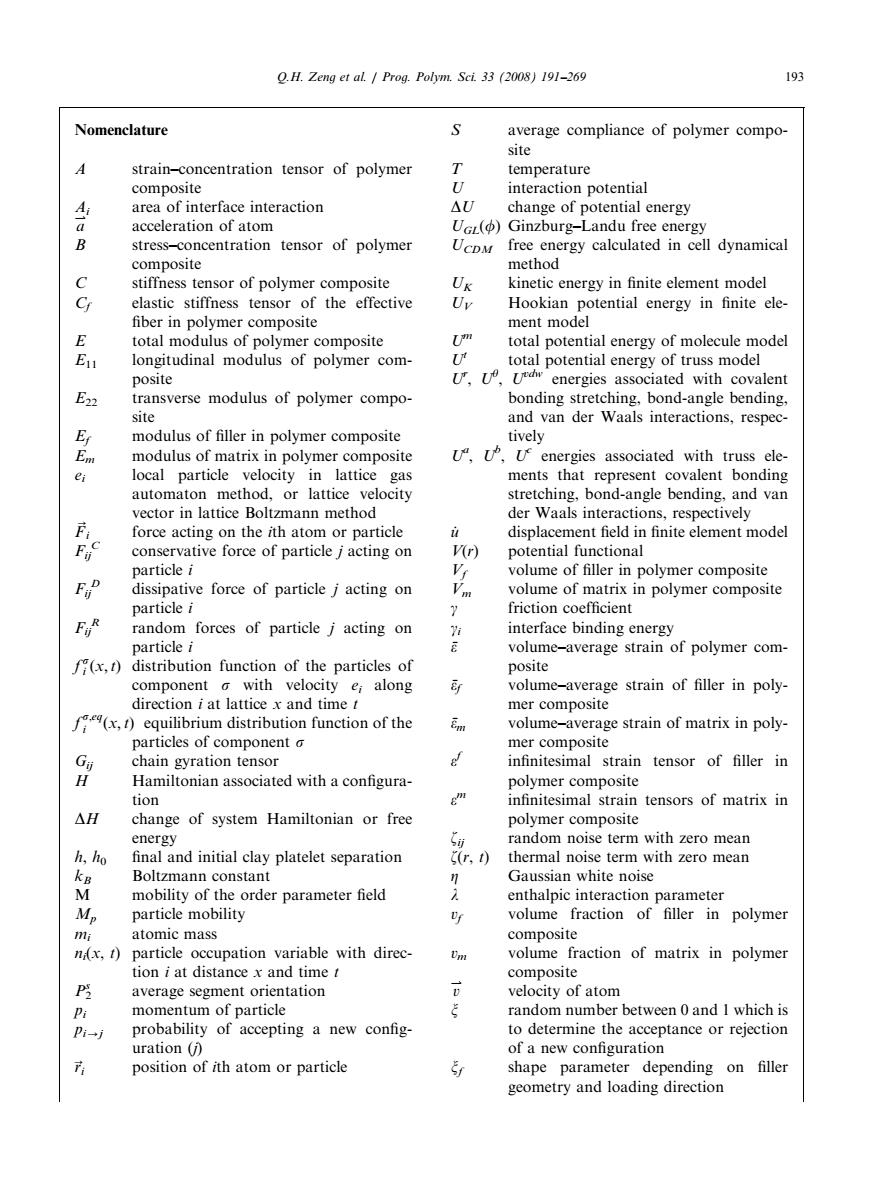正在加载图片...

Q.H.Zeng et al.Prog.Polym.Sci.33 (2008)191-269 193 Nomenclature S average compliance of polymer compo- site strain-concentration tensor of polymer T temperature composite U interaction potential A area of interface interaction △U change of potential energy acceleration of atom UGL()Ginzburg-Landu free energy B stress-concentration tensor of polymer UCDM free energy calculated in cell dynamical composite method O stiffness tensor of polymer composite UK kinetic energy in finite element model Cr elastic stiffness tensor of the effective Uv Hookian potential energy in finite ele- fiber in polymer composite ment model E total modulus of polymer composite Um total potential energy of molecule model E11 longitudinal modulus of polymer com- U total potential energy of truss model posite U Udh energies associated with covalent E22 transverse modulus of polymer compo- bonding stretching,bond-angle bending, site and van der Waals interactions,respec- Er modulus of filler in polymer composite tively Em modulus of matrix in polymer composite UU energies associated with truss ele- ei local particle velocity in lattice gas ments that represent covalent bonding automaton method,or lattice velocity stretching,bond-angle bending,and van vector in lattice Boltzmann method der Waals interactions,respectively force acting on the ith atom or particle displacement field in finite element model Fyc conservative force of particle j acting on V(r) potential functional particle i Vt volume of filler in polymer composite dissipative force of particle j acting on volume of matrix in polymer composite particle i friction coefficient FyR random forces of particle j acting on interface binding energy particle i E volume-average strain of polymer com- f(x,t)distribution function of the particles of posite component a with velocity e;along 可 volume-average strain of filler in poly- direction i at lattice x and time t mer composite (x,)equilibrium distribution function of the 高m volume-average strain of matrix in poly- particles of component a mer composite G chain gyration tensor infinitesimal strain tensor of filler in H Hamiltonian associated with a configura- polymer composite tion infinitesimal strain tensors of matrix in △H change of system Hamiltonian or free polymer composite energy random noise term with zero mean h,ho final and initial clay platelet separation (r,t) thermal noise term with zero mean kB Boltzmann constant Gaussian white noise M mobility of the order parameter field enthalpic interaction parameter Mp particle mobility 0 volume fraction of filler in polymer 171 atomic mass composite nx,t)particle occupation variable with direc- Um volume fraction of matrix in polymer tion i at distance x and time t composite P average segment orientation velocity of atom Pi momentum of particle 5 random number between 0 and I which is Pi-→j probability of accepting a new config- to determine the acceptance or rejection uration ( of a new configuration position of ith atom or particle 5 shape parameter depending on filler geometry and loading directionARTICLE IN PRESS Nomenclature A strain–concentration tensor of polymer composite Ai area of interface interaction a * acceleration of atom B stress–concentration tensor of polymer composite C stiffness tensor of polymer composite Cf elastic stiffness tensor of the effective fiber in polymer composite E total modulus of polymer composite E11 longitudinal modulus of polymer composite E22 transverse modulus of polymer composite Ef modulus of filler in polymer composite Em modulus of matrix in polymer composite ei local particle velocity in lattice gas automaton method, or lattice velocity vector in lattice Boltzmann method F ~i force acting on the ith atom or particle Fij C conservative force of particle j acting on particle i Fij D dissipative force of particle j acting on particle i Fij R random forces of particle j acting on particle i f s i ðx;tÞ distribution function of the particles of component s with velocity ei along direction i at lattice x and time t f s;eq i ðx; tÞ equilibrium distribution function of the particles of component s Gij chain gyration tensor H Hamiltonian associated with a configuration DH change of system Hamiltonian or free energy h, h0 final and initial clay platelet separation kB Boltzmann constant M mobility of the order parameter field Mp particle mobility mi atomic mass ni(x, t) particle occupation variable with direction i at distance x and time t P2 s average segment orientation pi momentum of particle pi-j probability of accepting a new configuration (j) ~ri position of ith atom or particle S average compliance of polymer composite T temperature U interaction potential DU change of potential energy UGL(f) Ginzburg–Landu free energy UCDM free energy calculated in cell dynamical method UK kinetic energy in finite element model UV Hookian potential energy in finite element model Um total potential energy of molecule model Ut total potential energy of truss model Ur , Uy , Uvdw energies associated with covalent bonding stretching, bond-angle bending, and van der Waals interactions, respectively Ua , Ub , Uc energies associated with truss elements that represent covalent bonding stretching, bond-angle bending, and van der Waals interactions, respectively u_ displacement field in finite element model V(r) potential functional Vf volume of filler in polymer composite Vm volume of matrix in polymer composite g friction coefficient gi interface binding energy ¯ volume–average strain of polymer composite ¯f volume–average strain of filler in polymer composite ¯m volume–average strain of matrix in polymer composite e f infinitesimal strain tensor of filler in polymer composite e m infinitesimal strain tensors of matrix in polymer composite zij random noise term with zero mean z(r, t) thermal noise term with zero mean Z Gaussian white noise l enthalpic interaction parameter vf volume fraction of filler in polymer composite vm volume fraction of matrix in polymer composite v * velocity of atom x random number between 0 and 1 which is to determine the acceptance or rejection of a new configuration xf shape parameter depending on filler geometry and loading direction Q.H. Zeng et al. / Prog. Polym. Sci. 33 (2008) 191–269 193���